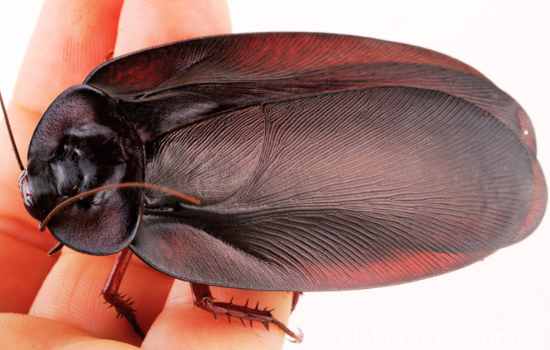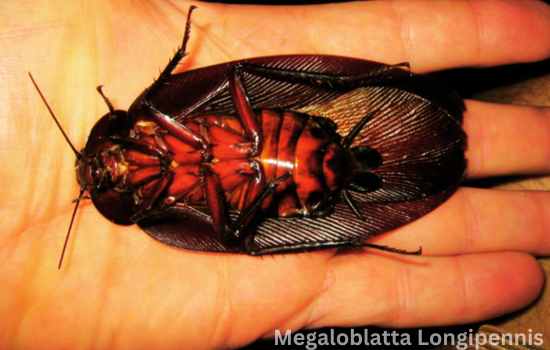The Megaloblatta Longipennis is the largest species of cockroach, with a wingspan of up to 8 inches. This incredible insect can be found in Central and South America.
At first glance, the Megaloblatta Longipennis may inspire fear and disgust, but it is actually a fascinating creature worthy of admiration. With its impressive size and distinctive appearance, this species has captured the curiosity of entomologists and nature enthusiasts alike.

We will delve into the unique characteristics of the Megaloblatta Longipennis, exploring its habitat, behavior, and impact on its ecosystem. Join us on this journey as we unlock the secrets of this giant cockroach and gain a deeper understanding of its place in the natural world.
What Is Megaloblatta Longipennis?
Megaloblatta Longipennis is a species of giant cockroach found in the rainforests of Central and South America. It is one of the largest cockroach species in the world, with a length of up to 3 inches. Despite its intimidating size, it is harmless to humans and primarily feeds on decaying plant matter.
Know More: Dubia Cockroach
Why Is It Called Megaloblatta Longipennis
Megaloblatta Longipennis, also known as the giant cockroach, gets its name due to its massive size and long wings. This species of cockroach is one of the largest in the world, with females reaching up to 7 centimeters in length.
The name “Megaloblatta” comes from the Greek words “megas” meaning large and “blatta” meaning cockroach. “Longipennis” refers to its elongated wings, which are essential for its ability to fly. The term “Megaloblatta Longipennis” thus perfectly describes the physical characteristics that distinguish this formidable insect.
Despite its intimidating size, this species is not harmful to humans and plays an important role in nature’s ecosystem. Understanding the reasons behind its name can help us appreciate the diversity and extraordinary adaptations found in the insect world.
Megaloblatta Longipennis Size
Megaloblatta Longipennis is a species of cockroach commonly found in Central and South America. It is one of the largest cockroach species, with an average size of about 7. 5 centimeters. The females are usually larger than the males, reaching lengths of up to 10 centimeters.

The size of Megaloblatta Longipennis is a result of its evolutionary adaptation to its environment. Its large size allows it to better compete for resources and defend itself against predators. Despite its intimidating appearance, Megaloblatta Longipennis is not considered a pest and is not known to infest human dwellings.
Instead, it prefers to inhabit forest habitats, where it feeds on decomposing organic matter. Its size and ability to fly make it a fascinating and noteworthy insect in the world of entomology.
Can Megaloblatta Longipennis Roach Fly
Megaloblatta Longipennis, also known as the Flying Cockroach, is a fascinating insect. Despite its name, this species of cockroach does have the ability to fly. With wings spanning up to 7 inches long, the Megaloblatta Longipennis is one of the largest flying insects in the world.
It is predominantly found in Central and South America, where it inhabits tropical forests. This remarkable creature possesses a unique blend of cockroach and butterfly characteristics, making for an intriguing study. The ability of the Megaloblatta Longipennis to fly allows it to navigate the dense forest canopy and search for food sources and potential mates.
While cockroaches are generally associated with crawling, this species has truly defied expectations by taking to the skies. The remarkable nature of the Megaloblatta Longipennis underscores the variety and complexity of the natural world.
Read More: American Roaches
Biggest Cockroach In The World
Megaloblatta Longipennis, the biggest cockroach in the world, is a fascinating insect species. Its large size sets it apart from other roaches. With a wingspan of up to 7. 4 inches, this impressive creature can be found in the rainforests of Central and South America.

The Megaloblatta Longipennis boasts a brownish color and has the ability to fly, making it even more intriguing. Despite its intimidating appearance, it is harmless to humans and primarily feeds on decomposing organic matter. Its existence in the wild serves as a testament to the incredible diversity found in nature.
Observing these remarkable creatures can provide valuable insights into the complexity and adaptability of the animal kingdom. Discovering the Megaloblatta Longipennis reminds us to appreciate the wonders of the natural world and to continue exploring its many marvels.
Where Do Megaloblatta Longipennis Roach Live
Megaloblatta Longipennis roaches are commonly found in tropical rainforests, particularly in Central and South America. These large insects prefer living in damp, dark environments such as under leaf litter, fallen logs, or inside tree trunks. They thrive in areas with a high humidity level and abundant vegetation, providing them with ample food sources and hiding spots.
Megaloblatta Longipennis roaches are expert climbers and can be found on trees, where they feed on decaying organic matter and plant debris. Due to their size and ability to fly, they can cover significant distances in search of food and suitable habitats.
Their presence in rainforests is essential for nutrient recycling and decomposition, contributing to the overall ecosystem balance. Understanding their natural habitat is crucial for conservation efforts and sustainable forest management practices.
Megaloblatta Longipennis Habitat
Megaloblatta Longipennis, commonly known as the giant cockroach, is native to Central and South America. These insects prefer humid and tropical environments, such as rainforests and mangroves. Due to deforestation, their natural habitats have been shrinking, causing a decline in their population.
Megaloblatta Longipennis can be found in dense vegetation, caves, and tree hollows, where they seek shelter during the day. This nocturnal species is well adapted to life in the dark, with their large wings allowing them to fly swiftly and silently.
Their long antennae help them navigate their surroundings and detect food sources. These giant cockroaches primarily feed on decaying organic matter, but they can also scavenge for other insects. Despite their name and intimidating appearance, Megaloblatta Longipennis is harmless to humans and plays a vital role in the ecosystem as decomposers.
It is essential to protect their habitats to ensure their continued existence.
Megaloblatta Longipennis Lifespan
The lifespan of Megaloblatta Longipennis, also known as the Giant Cockroach, varies significantly depending on various factors. These factors include environmental conditions, availability of food sources, and the presence of predators. Typically, the lifespan of Megaloblatta Longipennis ranges from one to two years.
However, some individuals have been recorded to live up to three years under optimal conditions. These insects are known for their large size, with adults often reaching lengths of over four inches. Despite their intimidating appearance, Megaloblatta Longipennis primarily feed on plant matter and decaying organic material.
Their ability to adapt to different habitats allows them to thrive in diverse environments, from tropical forests to urban areas. Understanding the lifespan of these insects is essential for studying their behavior, distribution, and impact on ecosystems.
Megaloblatta Longipennis Location
Megaloblatta longipennis, also known as the giant cockroach, is commonly found in Central and South America. This species is known for its impressive size, with some individuals reaching lengths of up to four inches. Megaloblatta longipennis prefers to inhabit dense tropical forests, where it often resides in the leaf litter on the forest floor.
These cockroaches have adapted well to their environment, with their dark coloration allowing them to blend in seamlessly with their surroundings. Despite their large size, Megaloblatta longipennis is primarily herbivorous, feeding on a variety of plant materials. Researchers are still studying the behavior and ecology of these fascinating insects to learn more about their role in the ecosystem and their unique adaptations for survival in the forest environment.
FAQs On Megaloblatta Longipennis Roach
What Was The Biggest Cockroach Ever Found?
The biggest cockroach ever found measured 6. 7 inches long, making it the largest recorded specimen.
What Is Megaloblatta Longipennis In English?
“Megaloblatta longipennis in English refers to a large cockroach species known for its exceptional size. “
How Does Megaloblatta Longipennis Survive In The Rainforest?
Megaloblatta Longipennis has adapted several survival techniques to thrive in the rainforest environment. Its large size acts as a deterrent to predators while also helping it navigate through dense vegetation. This species can also fly when necessary, allowing it to escape danger or find additional food sources.
Conclusion
The Megaloblatta Longipennis is a fascinating insect that showcases the wonders of nature. Its impressive size, unique appearance, and remarkable adaptability make it a true marvel to behold. As a nocturnal creature, it plays a crucial role in maintaining the balance of its ecosystem by controlling pests and serving as a source of food for other organisms.
Understanding the life cycle and habits of Megaloblatta Longipennis can provide valuable insights into the intricate workings of our natural world. Whether you are an entomology enthusiast or simply fascinated by the diversity of life on Earth, this insect is sure to capture your attention.
So take a moment to appreciate the beauty and importance of this incredible creature and remember that there is still so much to explore and uncover within the vast depths of our natural world.
